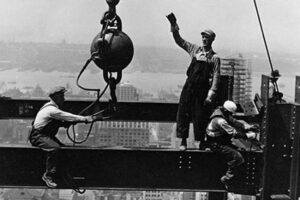The 1920s witnessed a building boom in the United States, particularly in major cities like New York, Chicago, and Philadelphia. This era saw the construction of numerous skyscrapers, transforming the skylines of these urban centers. These towering structures, reaching unprecedented heights, became symbols of economic prosperity and technological advancement.
The rapid growth of cities and the demand for office space fueled the skyscraper boom. Technological innovations, such as the development of steel-frame construction and high-speed elevators, enabled architects and engineers to design and build taller buildings than ever before. Skyscrapers offered several advantages: they maximized land use in densely populated areas, provided ample office space for businesses, and became iconic landmarks that enhanced the prestige of cities.
The construction of skyscrapers had a profound impact on urban development and architecture. It led to the emergence of new building techniques and materials, influenced urban planning and zoning regulations, and shaped the character of modern cities. The skyscrapers of the 1920s continue to stand as testaments to the ingenuity and ambition of that era, serving as enduring symbols of architectural innovation and urban progress.
1. Steel Frames
The advent of steel frames revolutionized skyscraper construction in the 1920s. Before this innovation, buildings were primarily constructed using load-bearing walls made of masonry or stone. However, these materials limited the height and size of buildings due to their weight and structural limitations. Steel frames, on the other hand, provided a lightweight and incredibly strong framework that could withstand the immense weight and wind forces acting on high-rise structures.
The use of steel frames allowed architects and engineers to design skyscrapers that were taller and more slender than ever before. The steel framework bears the weight of the building, enabling the creation of large open floor plans and expansive windows that characterize many skyscrapers. This flexibility in design also allowed for the incorporation of setbacks and other architectural features that enhanced the aesthetic appeal and functionality of these buildings.
One notable example of the transformative impact of steel frames is the Chrysler Building in New York City. Completed in 1930, the Chrysler Building was one of the tallest buildings in the world at the time and showcased the architectural possibilities of steel-framed construction. Its distinctive Art Deco design, featuring intricate setbacks and a gleaming stainless steel spire, would not have been possible without the use of a steel frame.
The development of steel frames was a pivotal technological advancement that enabled the construction of modern skyscrapers and shaped the skylines of cities around the world. It remains a fundamental component of high-rise construction, providing the structural integrity and flexibility necessary to create these architectural marvels.
2. Elevators
The invention and implementation of elevators played a transformative role in the construction of skyscrapers in the 1920s. Prior to their widespread use, buildings were limited in height due to the physical limitations of occupants climbing stairs. Elevators provided a safe, efficient, and convenient means of vertical transportation, making it feasible to construct buildings with dozens or even hundreds of stories.
The development of elevators went hand-in-hand with the advancement of steel-frame construction. Steel frames allowed for the creation of taller and more slender buildings, but these would have been impractical without a way to transport people and materials to the upper floors. Elevators solved this problem, enabling architects and engineers to design skyscrapers that reached new heights.
One notable example is the Empire State Building in New York City. Completed in 1931, the Empire State Building was the tallest building in the world at the time and featured 102 stories. The building’s 73 elevators were essential for its functionality, allowing tenants to quickly and easily access different parts of the building. The Empire State Building’s elevators were also a marvel of engineering, capable of traveling at speeds of up to 1,200 feet per minute.
The invention of elevators had a profound impact on the development of modern cities. Skyscrapers became a viable solution for accommodating the growing populations of urban centers, providing much-needed office space and housing. Elevators also made it possible to create mixed-use buildings, combining residential, commercial, and retail spaces within a single structure.
3. Economic Boom
The economic boom of the 1920s played a pivotal role in the construction of skyscrapers. The post-World War I period witnessed a surge in economic growth and prosperity in the United States, leading to increased demand for office space and housing in major cities.
- Increased Business Activity
The economic boom led to a surge in business activity, particularly in finance, manufacturing, and retail. Companies expanded their operations and sought to establish a presence in major cities, driving the demand for office space in skyscrapers.
- Population Growth
The economic boom also fueled population growth in cities as people migrated in search of job opportunities and better living conditions. This led to increased demand for housing, including apartments and residential skyscrapers.
- Technological Advancements
The economic prosperity of the 1920s enabled investment in new technologies and construction methods, such as steel-frame construction and elevators, which made the construction of skyscrapers possible and cost-effective.
- Speculation and Investment
The economic boom also led to speculation and investment in real estate, including skyscrapers. Investors saw skyscrapers as a lucrative investment opportunity, further driving their construction.
The economic boom of the 1920s thus created a favorable environment for the construction of skyscrapers, providing the financial resources, demand for space, and technological advancements necessary for the realization of these architectural marvels.
4. Technological Advancements
Technological advancements were indispensable to the construction of skyscrapers in the 1920s. These advancements included the development of steel-frame construction, elevators, and new building materials. Steel-frame construction, in particular, revolutionized skyscraper construction, enabling the creation of taller and more slender buildings than ever before.
Prior to the advent of steel-frame construction, buildings were primarily constructed using load-bearing walls made of masonry or stone. However, these materials limited the height and size of buildings due to their weight and structural limitations. Steel frames, on the other hand, provided a lightweight and incredibly strong framework that could withstand the immense weight and wind forces acting on high-rise structures.
The use of steel frames allowed architects and engineers to design skyscrapers that were taller and more slender than ever before. The steel framework bears the weight of the building, enabling the creation of large open floor plans and expansive windows that characterize many skyscrapers. This flexibility in design also allowed for the incorporation of setbacks and other architectural features that enhanced the aesthetic appeal and functionality of these buildings.
Another crucial technological advancement was the development of elevators. Prior to their widespread use, buildings were limited in height due to the physical limitations of occupants climbing stairs. Elevators provided a safe, efficient, and convenient means of vertical transportation, making it feasible to construct buildings with dozens or even hundreds of stories.
The invention and implementation of elevators played a transformative role in the construction of skyscrapers in the 1920s. Prior to their widespread use, buildings were limited in height due to the physical limitations of occupants climbing stairs. Elevators provided a safe, efficient, and convenient means of vertical transportation, making it feasible to construct buildings with dozens or even hundreds of stories.
In conclusion, technological advancements were essential to the construction of skyscrapers in the 1920s. These advancements, including steel-frame construction and elevators, enabled architects and engineers to design and build taller, more slender, and more functional skyscrapers than ever before.
5. Urban Growth
The rapid urban growth experienced in the 1920s was a significant factor that fueled the construction of skyscrapers. As cities expanded and populations surged, the demand for housing, office space, and commercial centers increased dramatically. Building skyscrapers provided a solution to accommodate this growing urban population and its associated needs.
Skyscrapers offered several advantages in addressing the challenges of urban growth. Their vertical design allowed for efficient land use in densely populated areas, maximizing space utilization. Additionally, skyscrapers provided ample office space for businesses and corporations, facilitating the growth of urban economies. Furthermore, the construction of skyscrapers created new residential options, addressing the housing needs of the growing urban population.
One notable example of the connection between urban growth and skyscraper construction is the development of New York City during the 1920s. As the city’s population soared, the demand for office space and housing intensified. In response, numerous skyscrapers were constructed, transforming the city’s skyline and accommodating its growing population. The Chrysler Building and the Empire State Building, completed in 1930 and 1931 respectively, stand as iconic examples of this building boom.
In conclusion, the connection between urban growth and building skyscrapers in the 1920s was profound. As cities expanded and populations increased, skyscrapers emerged as a practical and efficient solution to meet the growing demand for space, housing, and commercial centers. The construction of skyscrapers not only shaped the physical landscape of cities but also facilitated their economic and residential development.
6. Architectural Innovation
The architectural innovation of the 1920s was integral to the construction of skyscrapers, enabling the creation of taller, more efficient, and aesthetically striking buildings.
- Steel-Frame Construction
The use of steel frames revolutionized skyscraper construction, allowing for the creation of taller and more slender buildings than ever before. Steel frames provided a lightweight and incredibly strong framework that could withstand the immense weight and wind forces acting on high-rise structures. Notable examples include the Chrysler Building and the Empire State Building, both of which employed steel-frame construction to achieve their impressive heights.
- Setbacks and Terraces
To comply with zoning laws and provide natural light and ventilation to lower floors, architects incorporated setbacks and terraces into their designs. These features created a distinctive stepped appearance for many skyscrapers of the era, while also enhancing the livability and functionality of these buildings.
- Art Deco Style
The Art Deco style, characterized by its geometric forms, bold colors, and sleek lines, was a popular architectural style for skyscrapers in the 1920s. This style reflected the optimism and modernity of the era and added a touch of glamour to these towering structures.
- Ornamentation and Detail
Despite their impressive height, skyscrapers of the 1920s were often adorned with intricate ornamentation and details. These details, such as decorative spires, cornices, and window surrounds, added visual interest and broke up the monotony of the tall facades.
The architectural innovations of the 1920s not only enabled the construction of skyscrapers but also shaped their aesthetic and functional qualities. These innovations continue to influence skyscraper design and construction today, ensuring that these iconic structures remain symbols of architectural achievement and urban progress.
7. Land Use Optimization
The connection between “Land Use Optimization” and “building skyscrapers in the 1920’s” is significant, as skyscrapers emerged as a solution to the increasing demand for space and efficient land use in densely populated urban areas. During this period, cities experienced rapid growth and expansion, leading to a scarcity of land for development.
Skyscrapers provided a practical solution by maximizing vertical space utilization, allowing for the construction of numerous buildings within a limited land area. This vertical approach to development not only conserved valuable land but also facilitated the concentration of businesses, residential units, and commercial centers within close proximity, enhancing accessibility and convenience.
One notable example of land use optimization through skyscrapers is the development of New York City during the 1920s. As the city’s population surged, the demand for space intensified. The construction of skyscrapers, such as the Chrysler Building and the Empire State Building, allowed for the creation of ample office space, residential units, and commercial centers within a relatively small geographic area. This efficient use of land contributed to the city’s economic growth and prosperity.
In conclusion, the connection between “Land Use Optimization” and “building skyscrapers in the 1920’s” is evident in the innovative approach to maximizing vertical space utilization. Skyscrapers emerged as a practical solution to the challenges of urban growth and land scarcity, allowing for the efficient concentration of various functions within a limited area. This understanding highlights the importance of land use optimization in urban planning and development, ensuring the efficient and sustainable use of land resources.
FAQs about Building Skyscrapers in the 1920s
This section addresses frequently asked questions and misconceptions surrounding the construction of skyscrapers in the 1920s:
Question 1: Why were skyscrapers built in the 1920s?
The construction of skyscrapers in the 1920s was driven by several factors, including rapid urban growth, increasing demand for office space, and technological advancements in steel-frame construction and elevators.
Question 2: What were the challenges involved in building skyscrapers in the 1920s?
The construction of skyscrapers in the 1920s posed several challenges, such as the need for strong and lightweight building materials, efficient structural systems, and effective means of vertical transportation.
Question 3: How did steel-frame construction revolutionize skyscraper construction?
Steel-frame construction revolutionized skyscraper construction by providing a strong and lightweight framework that could withstand the immense weight and wind forces acting on high-rise structures. This enabled the construction of taller and more slender buildings than ever before.
Question 4: What role did elevators play in the development of skyscrapers?
Elevators played a pivotal role in the development of skyscrapers by providing a safe, efficient, and convenient means of vertical transportation. This made it feasible to construct buildings with dozens or even hundreds of stories, accommodating a large number of occupants and maximizing land use.
Question 5: How did the Art Deco style influence skyscraper design in the 1920s?
The Art Deco style, characterized by its geometric forms, bold colors, and sleek lines, was a popular architectural style for skyscrapers in the 1920s. This style added a touch of glamour and modernity to these towering structures and influenced their overall aesthetic.
Question 6: What are some of the iconic skyscrapers built in the 1920s?
Some of the most iconic skyscrapers built in the 1920s include the Chrysler Building, the Empire State Building, and the Bank of Manhattan Trust Building in New York City.
In conclusion, the construction of skyscrapers in the 1920s was a testament to human ingenuity and technological advancements. These towering structures continue to shape the skylines of cities around the world and stand as symbols of architectural achievement.
Transition to the next article section:
The following section will delve into the impact of skyscrapers on urban development and the innovations that have shaped high-rise construction over the decades.
Tips for Building Skyscrapers in the 1920s
The construction of skyscrapers in the 1920s was a complex and challenging endeavor that required careful planning and execution. Here are a few tips that were crucial for the successful construction of these towering structures:
Tip 1: Utilize Steel-Frame Construction
Steel-frame construction emerged as a revolutionary technique for skyscraper construction in the 1920s. Steel frames provided a lightweight yet strong framework that could withstand the immense weight and wind forces acting on high-rise buildings. This enabled architects and engineers to design and construct skyscrapers that reached unprecedented heights.
Tip 2: Implement Efficient Elevator Systems
Elevators were essential for making skyscrapers accessible and functional. The development of safe and efficient elevator systems was crucial for the vertical transportation of people and materials within these towering structures. Elevators enabled occupants to quickly and conveniently access different floors, enhancing the overall functionality and usability of skyscrapers.
Tip 3: Optimize Land Use
Skyscrapers played a vital role in optimizing land use, especially in densely populated urban areas. By building vertically, cities could accommodate a growing population and businesses within a limited land area. Skyscrapers allowed for the concentration of commercial, residential, and office spaces within a single structure, maximizing land utilization and promoting efficient urban planning.
Tip 4: Employ Innovative Architectural Designs
Skyscrapers of the 1920s were not just feats of engineering but also works of architectural art. Architects experimented with various design styles, including Art Deco and Gothic Revival, to create visually stunning and iconic structures. These designs incorporated setbacks, terraces, and intricate ornamentation, enhancing the aesthetic appeal of skyscrapers and contributing to the overall cityscape.
Tip 5: Utilize Advanced Construction Techniques
The construction of skyscrapers required advanced construction techniques and technologies. Reinforced concrete and innovative structural systems were employed to ensure the stability and integrity of these towering structures. Engineers and architects worked together to develop new methods for erecting and assembling skyscrapers, pushing the boundaries of construction capabilities.
By adhering to these tips, architects and engineers were able to successfully construct skyscrapers in the 1920s, forever changing the skylines of major cities and shaping the future of urban development.
Key Takeaways:
- Steel-frame construction provided a strong and lightweight framework for skyscrapers.
- Efficient elevator systems facilitated vertical transportation and enhanced functionality.
- Skyscrapers optimized land use in densely populated urban areas.
- Innovative architectural designs added aesthetic value and iconic status to skyscrapers.
- Advanced construction techniques ensured the stability and integrity of these towering structures.
The construction of skyscrapers in the 1920s stands as a testament to human ingenuity and engineering prowess. These architectural marvels continue to inspire and amaze, serving as symbols of urban progress and architectural achievement.
Conclusion
The construction of skyscrapers in the 1920s transformed skylines, redefined urban landscapes, and left an indelible mark on the architectural landscape. Driven by factors such as urban growth, technological advancements, and economic prosperity, these towering structures became symbols of progress and innovation.
The development of steel-frame construction and efficient elevator systems enabled the realization of skyscrapers that reached unprecedented heights. Architects and engineers pushed the boundaries of design, experimenting with various architectural styles and incorporating setbacks and terraces to enhance aesthetics and functionality. Skyscrapers not only provided much-needed office space and housing but also optimized land use in densely populated urban areas.
The legacy of skyscrapers built in the 1920s continues to shape modern architecture and urban planning. These iconic structures stand as testaments to human ingenuity and engineering prowess, serving as reminders of an era of architectural innovation and urban expansion. As we look to the future, the lessons learned and techniques developed during this pivotal period will undoubtedly continue to influence the construction of tall buildings and the design of our cities.







